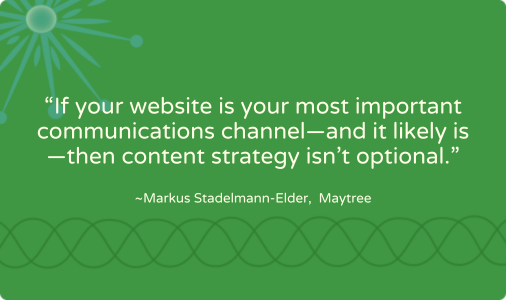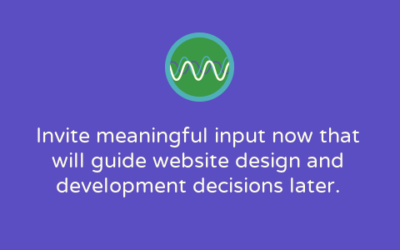How old is your nonprofit organization’s website content strategy? When should you revisit it? For Markus Stadelmann-Elder, the right interval was five years.
I’ve collaborated with Markus in so many ways over the years that I’m sure I’ve lost track of some. Markus is the Director of Communications at Maytree, an organization addressing poverty through a human rights-based approach. Markus is a trusted friend, valued content collaborator (on this blog and the now-retired Nonprofit MarCommunity blog), and a repeat client. Markus, along with his colleagues, has also hosted me twice as a speaker in Maytree’s Five Good Ideas series.
My first client project with Markus took place in 2017 when we developed the content strategy for Maytree’s website. Five years later, we revisited this work, creating a new strategy in 2022. Clearly, Markus cares deeply about preventing Maytree’s website — and its content — from stagnating!
Because this level of diligence and commitment to strong website content is not always easy, it’s also unusual, so I was interested in asking Markus about it. The result is this interview, in which Markus shares why he repeated this process after five years, how the 2022 website content strategy connects back to our earlier work, and how he benefited from going through it a second time.
Revisiting website content strategy: interview with Markus Stadelmann-Elder at Maytree
Why is a strong website content strategy fundamental to your nonprofit’s communications?
“I’ve always believed that our website is the heart of our communications. It’s where people go to learn about who we are, what we do, and how we can help them. It’s also where they discover other organizations working on the issues they care about.
Without a clear strategy, we’d be flying blind. We wouldn’t know what content to focus on, what content actually resonates, and whether we’re just speaking to ourselves. A strong strategy provides us with a roadmap that guides us.”

You completed a website content strategy in 2017. What motivated you to return to this approach—and to working with me—in 2022?
“Back in 2017, we were just starting to shift into a new issue area, and developing a content strategy helped us focus our direction. Five years later, we had a clearer sense of our work, but also recognized that some of our early assumptions had changed. Because the first strategy was so successful—not just in outcomes, but in how engaged our team felt—I wanted to work with you again.
It really came down to continuity. I’ve always seen you, Marlene, as part of the team. You understood our work and where we were headed, and I knew your insights would be invaluable. Most importantly, we shared a fundamental understanding: that any web project must begin with a solid content strategy. That alignment was key.”
In what ways did your strategy inform and guide web development and design decisions?
“The strategy gave us a clear picture of who our audiences were and what content they would look for. That clarity shaped how we worked with our web development partner—from the site’s structure to its design. It gave us a clear view of what we wanted to achieve.”
How did your strategy help you prioritize which content to feature most prominently or which calls to action to use?
“One of the important changes from the first strategy to the one in 2022 was how we approached personas. In the earlier version, we created highly detailed, almost overly complex profiles. They weren’t as flexible as we needed them to be.
In 2022, we took a more high-level approach, using storytelling to shape our personas. That shift made the audiences feel more relatable, and it was easier to visualize how they’d navigate the site. It also helped us write content with their needs in mind.”
How did the strategy help you determine metrics for assessing the effectiveness of your website content?
“Because we had such a clear understanding of our audiences, we could define success in more specific ways. For example, if one audience group was primarily interested in our policy work, we tracked metrics like report downloads, newsletter sign-ups following a release, and outreach to our policy staff.
Each audience had its own indicators of engagement—and the strategy helped us identify those in advance, rather than guessing after the fact.”
How did you, as project lead, benefit from the process and/or from working with me? How did your colleagues benefit?
“One of the biggest advantages was having an outside perspective. You came in with fresh eyes with no need to defend past decisions. That helped me look at our content and structure with more honesty.
It also made it easier to involve the whole team. The process created space for everyone to be part of the conversation, and people felt their voices were heard. That buy-in made a huge difference, both during the project and after launch.”
Is the strategy still useful for you today?
“Absolutely. I still refer to it regularly to make sure we’re staying focused on our core audiences. It keeps us grounded.
Right now, I’m once again reviewing our audience strategy, and the 2022 strategy serves as a strong foundation. We’re able to look back at it and ask: ‘Is this still true?’ It’s been a great point of continuity.”
If you could offer one piece of advice to your peers about prioritizing content strategy in a website project, what would it be?
“If your website is your most important communications channel—and it likely is—then content strategy isn’t optional.
It’s what grounds your work in the real needs of your audiences. It helps you define success. Without it, you might end up with a slick, beautiful site that ultimately says nothing to the people you’re trying to reach. A strong content strategy makes sure your site has substance, not just style.”
Takeaways and next steps
Thank you, Markus, for sharing your insights about revisiting your nonprofit’s website content strategy! Here are a few points that stood out to me:
- Buy-in from internal stakeholders. I’m so pleased to hear another client affirm that a consultative approach to website content strategy development has enabled their colleagues to feel heard, and buy into the process and final website.
- A helpful level of audience exploration. Markus’s comments about our audience work reminded me that I’ve shifted my approach over the years. In a website content strategy project, we delve directly into exploring what a nonprofit’s visitors want to learn and do on their website, which goes a long way toward creating meaningful and useful content.
- Value beyond the website build. It’s great to hear that the work we did together has value beyond the website project itself, with Markus using insights from the strategy to inform other communications efforts.
- Meaningful content. Markus is as passionate about starting with strategy as I am! I loved his framing of prioritizing a website with substance.
And of course, I’m thrilled to hear that another happy client thinks of me as an extension of their team.
Would you like to achieve the same positive results as Markus when preparing for a new website build? Check out my website content strategy package for nonprofits and then request a consultation.




